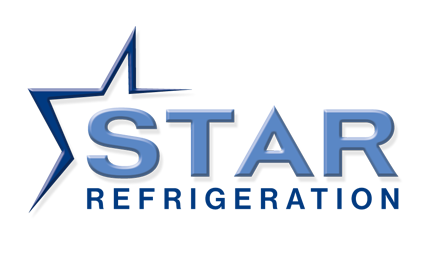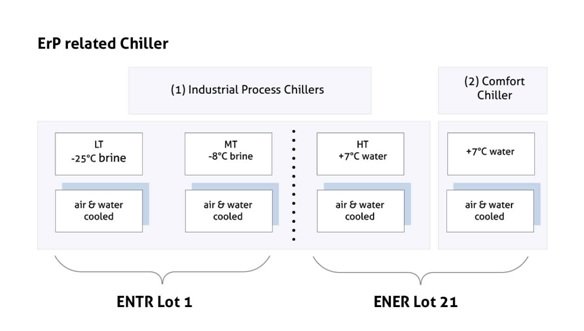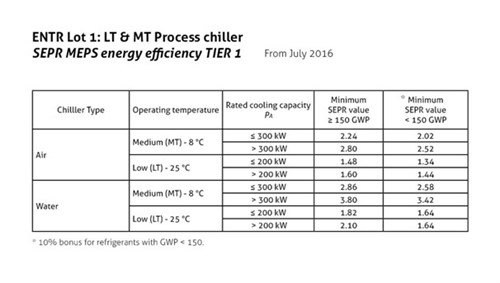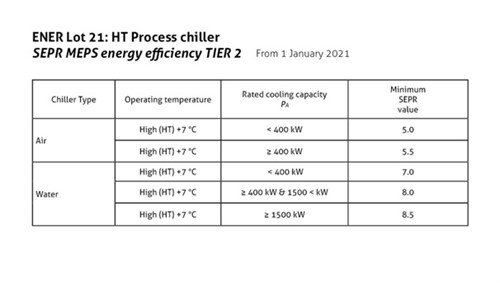
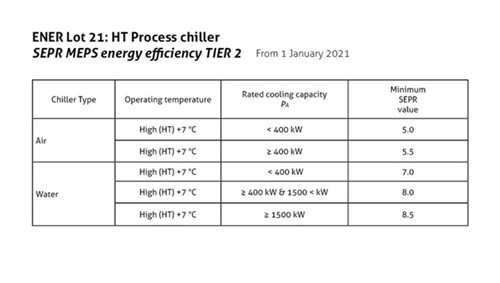
Implementation of the EcoDesign Directive
The regulation for each LOT will be implemented in two phases – a more lenient Tier 1 will be upgraded with stricter and final Tier 2 following a scheduled programme of action which started in July 2016 and will conclude on 5th May 2020 for LT and MT chillers, and by 1st January 2022 for HT and Comfort chillers. The regulations make provision for the inclusion of a review at a later date but not later tahn 1st Jan 2022 which may further tighten requirements or extend the scope of existing regulations to incorporate additional products (e.g. process chillers using evaporative condensers may be incorporated at a later date).
The EC Regulation for MT and LT Process Chillers and Condensing Units has become applicable since 1st July 2016. Since then it is mandatory for refrigeration manufacturers of these products to declare performance and other technical details in accordance with the regulations. Some products covered by this regulation also require specific labelling under the Energy Labelling Directive (2010/30/EU), though this does not apply to process chillers or condensing units. Products not meeting the requirements of the regulations in any respect, may no longer be placed on the market in Europe. The directive also introduced an energy efficiency bonus for condensing units and process chillers that use refrigerants with GWP < 150.
Unlike the regulation for LT and MT process chillers, which has a 10% bonus for MEPS to encourage use of low GWP (< 150) refrigerants, the new regulations for HT and comfort chillers has no incentive for selection of refrigerant.
More information can be found at
2009 Ecodesign Directive 2009/125/EC :
https://eur-lex.europa.eu/legal-content/EN/TXT/PDF/?uri=CELEX:32009L0125&from=EN
2015 LT & MT Regulations 2015/1095 :
https://eur-lex.europa.eu/legal-content/EN/TXT/PDF/?uri=CELEX:32015R1095&from=EN
2016 HT & Comfort Regulations 2016/2281 :
https://eur-lex.europa.eu/legal-content/EN/TXT/PDF/?uri=CELEX:32016R2281&from=EN
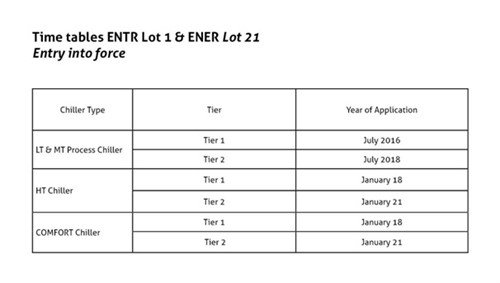
The regulations also make provision for each Member State to perform market surveillance checks i.e. any chiller placed on the market post-introduction of the regulations may be selected for testing by a body appointed by the Member State to verify that the chiller achieves the stated performance within an agreed tolerance. In the UK, this function is administered by the National Measurement and Regulation Office (NMRO). End users can therefore have confidence that the energy efficiency claimed by a manufacturer is indeed achieved.
How does the EcoDesign regulation affect end-users of cooling equipment?
The Directive has set very high energy efficiency requirements for the future. So much so that during consultations industry stakeholders voiced concerns about the Minimum Energy Performance Standards targets being “overstated.” Targets were seen to be “very challenging” and a call to the EU Commission for lowering them was made without success – MEPS will be mandatory across Europe and it will be unlawful to place products within the EU market that fail to achieve the prescribed minimum energy performance standard.
Products covered by the new regulations which were installed before the date the regulations became effective are not affected by these requirements and need not be replaced or upgraded. MEPS will also trigger investment in cost effective solutions, thereby reducing energy use and associated cost and carbon emissions.
With such a stringent legislative environment, it will be essential that industrial refrigeration manufacturers commit to R&D in order to develop solutions that meet the normative and offer customers a better alternative than existing cooling products. This will stimulate market changes to speed up the rate at which energy efficiency upgrades to inefficient industrial cooling and heating systems take place.
Star’s Azanechiller 2.0 goes above and beyond even the tightest MEPS of the directive, with efficiency figures that are up to 146% higher than the European EcoDesign Directive requirement for Medium Temperature chillers, up to 100% higher for comfort cooling chillers and up to 74% higher for High Temperature chiller applications.
For refrigeration end-users, these measures mean good news all round. EU targets will positively impact business owners’ use of energy, who should be able to see a reduction of the energy bill as soon as chillers that meet the directive are installed at their facilities.
End-user businesses will benefit from:
- More energy efficient equipment from manufacturers of industrial cooling equipment.
- More efficient chillers will help organisations manage their Carbon Reduction Commitment compliance and avoid penalties.
- The Directive will allow end users to use the information provided by manufacturers effectively in order to be able to make informed decisions that directly contribute to business success. The SEPR and Seasonal Space Cooling Energy Efficiency must be declared and technical documentation provided by the manufacturers – however, there is not a set energy rating label.
- The SEPR and Seasonal Space Cooling Energy Efficiency figures are based on more realistic conditions compared to other currently used ratios and provide the refrigeration end-user with more data to identify the most efficient solution. More efficient solutions will result in higher operating efficiency and reduced customer’s energy bills.
- Energy efficient business can gain a competitive advantage over less efficient companies, leading to a profit increase.
- Investment in highly efficient, low Global Warming Potential (GWP) refrigeration technology will reduce the overall CO2 emissions of end user businesses and potentially serve as a significant marketing tool, as public perception of “green” companies takes an increasing role in purchasing decisions.
Azanechiller 2.0 vs EcoDesign Directive MEPS
Star Refrigeration chillers meet even the most stringent 2nd tier targets of the EcoDesign Directive. Star’s Azanechiller Seasonal Space Cooling Energy Efficiency for comfort cooling applications reaches 236% and the Seasonal Energy Performance Ratio (SEPR) is as high as 8.01 for process cooling.
At Star we have always placed great emphasis on the chillers’ development stages, specifically at the design and manufacturing phases to eliminate sources of energy waste.
Star’s chillers have been proven to significantly reduce overall energy consumption and minimise adverse environmental impact throughout their entire life-cycle.
The company’s latest development, the Azanechiller 2.0, sets a new benchmark in chiller performance with efficiency figures that are up to 146% higher than the European EcoDesign Directive requirement for Medium Temperature chillers, up to 100% higher for Comfort Cooling chillers and up to 74% higher for High Temperature chillers.
Comfort Chillers
For high temperature +7°C chillers used for comfort cooling, typically for building services, the metric used by the EcoDesign Directive is called Seasonal Space Cooling Energy Efficiency (SEER * 0.4) and it is expressed as a percentage. The graph shows cooling capacity across the bottom and Seasonal Space Cooling Energy Efficiency for comfort chillers on the vertical axis.
The minimum energy performance standard is between 149% and 161% for all air cooled chillers. All of the high temperature (HT) Azanechillers 2.0 exceed the benchmark by at least 77%.

High Temperature Process Chillers
For the high temperature (HT) process chillers operating with water temperatures of +7°C off, the metric used is the SEPR. The graph below shows the range of HT process chillers which have a minimum efficiency performance standard of between 4.5 and 5, introduced from January 2018. Star Refrigeration’s ammonia chillers exceed this benchmark also by a wide margin, with the best unit being above 8.00, against a standard of 5.00.

Low and Medium Temperature Process Chillers
For low temperature (LT) and medium temperature (MT) process chillers with a nominal design glycol off-temperature of -25°C and -8°C respectively, the metric used to measure efficiency is the Seasonal Energy Performance Ratio (SEPR). The minimum efficiency performance standard introduced from July 2016 is between 2.02 and 2.52 for MT process chillers, accounting for the bonus applied where the refrigerant has GWP < 150. The first Star MT process chiller manufactured for 415kW has an SEPR 74% higher than the standard.
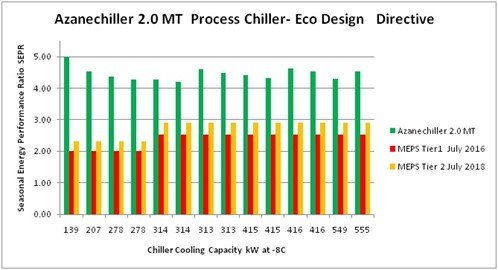
This article has been certified for Continuing Professional Development (CPD) by CIBSE and The CPD Certification Service. To get your CPD Certificate please email your request to CPDCertificate@star-ref.co.uk
